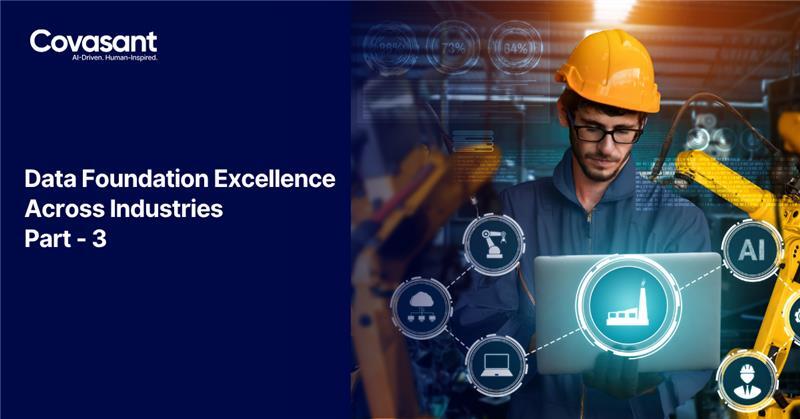Designing Scalable Data Platforms for Smart Manufacturing & Industry 4.0

Industry 4.0 is revolutionizing how the manufacturing industry operates, combining automation, cyber-physical systems, IoT, and AI. What sets smart factories apart is their ability to harness data as a core asset. This transformation requires robust, real-time cloud-based data platforms that can ingest, process, and act upon insights from an ever-growing number of connected machines and sensors.
Traditional architectures designed for retrospective ERP reporting are fundamentally incapable of keeping pace with modern data velocity and variety. To unlock agility, predictive capability, and cross-system orchestration, manufacturers need scalable data foundations supported by strong data engineering practices.
This blog explores how a well-designed, AI-ready data architecture serves as the bedrock of digital transformation in manufacturing, delivering operational efficiency, quality control, supply chain resilience, and AI-readiness.
Why Traditional Architectures Fall Short
Legacy systems have been deeply entrenched in manufacturing enterprises for decades. They served their purpose in a pre-IoT world but are no longer sufficient.
- Siloed Data: Separate systems for MES, ERP, SCADA, and CRM create fragmented views of operations.
- Limited Real-Time Capability: Insights arrive hours or days later, too late to prevent quality issues.
- No AI/ML Integration: Historical reports don’t support streaming AI pipelines or predictive analytics solutions.
- Infrastructure Bottlenecks: On-prem clusters can't elastically scale to meet sudden data bursts.
As a result, teams rely on spreadsheets and manual workarounds, delaying decision-making and reducing visibility into the shop floor. A shift to a modern, cloud-native architecture is long overdue.
What Makes a Platform Smart Manufacturing Ready?
A manufacturing-grade data platform must support multimodal data flows, high-volume processing, low-latency computation, and governed self-service. Below are the essential pillars:
1. Multi-Modal Data Ingestion
Modern factories generate a torrent of industrial IoT data from a variety of sources:
- Streaming: Sensor telemetry, PLC data, vibration logs, and real-time alerts
- Batch: Inventory snapshots, BOMs, QC results, and ERP logs
- APIs: Integration with external partners (logistics, vendors, regulatory bodies)
Tools like Kafka, Azure IoT Hub, Google IoT Core, and MQTT provide the backbone for secure, scalable, and device-aware data ingestion pipelines.
2. Unified Data Lakehouse Layer
Storing raw and curated data in the same system using open formats (Delta Lake, Iceberg) allows both real-time access and governance.
- Cloud-native object storage keeps costs low
- Table formats support schema evolution and ACID guarantees
- Supports both SQL-based BI and Python-based ML workloads
The data lakehouse architecture enables a single source of truth for both time-series and structured data.
3. Edge + Cloud Intelligence
Manufacturing demands both edge computing and centralized cloud analytics. Edge devices pre-process data for low latency (e.g., shut down a machine when temperature crosses a threshold), while cloud data pipelines aggregate and analyze trends across plants.
- Deploy edge runtimes for inference
- Sync data upstream during off-peak hours
- Run federated ML training using cloud-orchestrated workloads
This architecture ensures agility, visibility, and scalability across distributed environments.
4. Modular Data Models & Digital Twins
Modern data platforms are semantic by design. Modular data models capture business entities such as:
- Equipment, Maintenance Schedule, Defect, Production Run, Work Cell
- Operators, Shifts, Plant Location, Materials, Supplier Batch
Digital Twins mirror physical assets in the digital world. Combined with time-series analytics, they power predictive maintenance, proactive asset performance optimization, and continuous process improvement.
5. AI/ML Readiness & Feature Stores
Predictive analytics sits at the heart of smart manufacturing. But training robust ML models requires reusable, high-quality features.
- Create features from time-windowed sensor data (e.g., average vibration over 30 mins)
- Store features in Vertex AI or Feast for repeatable model development
- Enable real-time scoring via streaming model deployment
Use cases include predictive maintenance, yield forecasting, anomaly detection, and vision-based defect classification; key applications of AI engineering services in manufacturing.
Use Cases Driving Platform Design
A modern data platform enables high-impact use cases:
- Predictive Maintenance: Forecast failures before they happen using vibration and energy signals
- Defect Prediction: Use visual inspections and environmental conditions to predict quality issues
- Energy Optimization: Track consumption trends and detect inefficiencies
- Production Scheduling: Real-time order flow vs. capacity planning
- Supply Chain Resilience: Identify supplier delays and trigger proactive adjustments
These AI-powered analytics capabilities help organizations advance toward Industry 4.0 transformation.
Architecture Overview
Below is a simplified but representative architecture of a scalable smart manufacturing platform:

Figure: Scalable Smart Manufacturing Platform Architecture
Design Principles That Ensure Scalability
To make the platform robust, scalable, and future-proof, enterprises should adopt the following principles:
- Domain-Decoupled Design: Isolate ingestion, storage, processing, and serving layers.
- Unified Processing Engine: Use the same engine for batch and streaming workloads.
- Platform-as-a-Product: Treat your platform as an internal product with SLAs.
- Self-Service Enablement: Empower teams to access and model data securely via APIs.
- Data Governance & Observability: Maintain visibility, security, and compliance across all layers.
These practices form the foundation of enterprise-grade data engineering platforms for AI and Industry 4.0.
Business Outcomes Delivered
Transforming to a smart, cloud-based data platform delivers measurable business impact. For example:
- Machine Downtime: Reduced from 3–5% to <1% with predictive insights
- Defect Rates: Decreased through real-time QC triggers
- Production Visibility: Shift from monthly reports to real-time dashboards
- Data Engineering TAT: Shrinks from weeks to hours
- AI Velocity: Accelerates model deployment from months to days
Closing Thoughts
The journey to Industry 4.0 starts with data engineering excellence. While sensors and robots may make a factory smart, it’s the data foundation that makes it intelligent.
Manufacturers that invest in cloud-native, AI-ready, and streaming-enabled data architectures will outpace competition, not just in cost and quality, but in adaptability and innovation.



